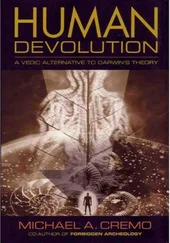Michael Cremo - Forbidden Archeology - The Hidden History of the Human Race
Здесь есть возможность читать онлайн «Michael Cremo - Forbidden Archeology - The Hidden History of the Human Race» весь текст электронной книги совершенно бесплатно (целиком полную версию без сокращений). В некоторых случаях можно слушать аудио, скачать через торрент в формате fb2 и присутствует краткое содержание. Год выпуска: 1992, ISBN: 1992, Издательство: Torchlight Publishing, Жанр: Старинная литература, на английском языке. Описание произведения, (предисловие) а так же отзывы посетителей доступны на портале библиотеки ЛибКат.
- Название:Forbidden Archeology: The Hidden History of the Human Race
- Автор:
- Издательство:Torchlight Publishing
- Жанр:
- Год:1992
- ISBN:9780892132942
- Рейтинг книги:4 / 5. Голосов: 1
-
Избранное:Добавить в избранное
- Отзывы:
-
Ваша оценка:
- 80
- 1
- 2
- 3
- 4
- 5
Forbidden Archeology: The Hidden History of the Human Race: краткое содержание, описание и аннотация
Предлагаем к чтению аннотацию, описание, краткое содержание или предисловие (зависит от того, что написал сам автор книги «Forbidden Archeology: The Hidden History of the Human Race»). Если вы не нашли необходимую информацию о книге — напишите в комментариях, мы постараемся отыскать её.
Forbidden Archeology: The Hidden History of the Human Race — читать онлайн бесплатно полную книгу (весь текст) целиком
Ниже представлен текст книги, разбитый по страницам. Система сохранения места последней прочитанной страницы, позволяет с удобством читать онлайн бесплатно книгу «Forbidden Archeology: The Hidden History of the Human Race», без необходимости каждый раз заново искать на чём Вы остановились. Поставьте закладку, и сможете в любой момент перейти на страницу, на которой закончили чтение.
Интервал:
Закладка:
Others have arrived at different quantitative dates for St. Prest. Tage Nilsson (1983, p. 158) stated that two sites in the Central Massif region of France, Sainzelles and Le Coupet, yielded potassium-argon dates of 1.3–1.9 million years. Nilsson (1983, p. 158) then said: “St. Prest, near Chartres in northern France, is held to be closely related.” Nilsson considered the three sites Late Villafranchian, or Early Pleistocene.
Let us now consider some of the species that were listed as present at St. Prest. Elephas meridionalis (sometimes called Mammuthus meridionalis ) is said by modern authorities ( Maglio 1973, p. 79) to have existed in Europe from about 1.2 million to 3.5 million years ago. Osborn (1910, p. 313) places Rhinoceros (Dicerorhinus) leptorhinus in the Plaisancian (or Piacenzian) age of the Pliocene. Osborn placed the Plaisancian age in the Early Pliocene, but Romer (1966, p. 334) places the Plaisancian in the Late Pliocene. Rhinoceros (Dicerorhinus) etruscus, according to Nilsson (1983, p. 475), occurs in Europe from the Villafranchian, which begins in the Late Pliocene, to the early Middle Pleistocene. But Savage and Russell (1983, p. 339) list occurrences of Dicerorhinus etruscus as early as the Ruscinian age of the Early Pliocene. According to Osborn (1910, p. 313), Hippopotamus major, a larger version of the modern hippopotamus, is found in the Late Pliocene and throughout the Pleistocene in Europe. Hippopotamus major is sometimes referred to as Hippopotamus amphibius antiquus. This species is listed by Savage and Russell (1983, p. 351) as part of the Pliocene Villafranchian fauna of Europe. Trogontherium cuvieri, the giant extinct beaver, is found in Pliocene faunal lists (Savage and Russell 1983, p. 352) and persisted until the Mosbachian age of the early Middle Pleistocene (Osborn 1910, p. 403). Thus all the above species were in existence during the Pliocene period.
Add it all up, and it can be seen that a Late Pliocene date for St. Prest is not out of the question. And, as noted previously, some twentieth-century scientists (Pinchemel and Deperet) have in fact assigned St. Prest to this period. That would place toolmaking hominids in Europe at over 2 million years ago.
How recent could St. Prest possibly be? The presence of Elephas meridionalis, which survived in Europe until 1.2 million years ago (Maglio 1973, p. 79) would appear to impose a late Early Pleistocene limit. The potassiumargon dates of 1.3–1.9 million years for French sites having a fauna similar to that of St. Prest (Nilsson 1983, p. 158) offer another guidepost. Kurtén (1968, p. 24), like Boudier (1965), assigns St. Prest to the Waalian temperate stage of the Early Pleistocene. Some authorities place the Waalian stage at about 1.1–1.2 million years (Nilsson 1983, p. 144). But Senéze, a French site tentatively attributed to the Waalian temperate stage, is estimated to be about 1.6 million years old (Nilsson 1983, p. 158). From all this, one could conclude that the St. Prest site, at the more recent end of its probable date range, might be just 1.2–1.6 million years old. Even at this date, incised bones would still be anomalous. The oldest undisputed evidence for the presence of Homo erectus in Europe dates back only about 700,000 years (Gowlett 1984, p. 76). Also, the oldest occurrences of Homo erectus in Africa have dates of about 1.5 million years.
Even in the nineteenth century, Desnoyers’s discoveries of incised bones at St. Prest provoked controversy. Professor Bayle, a paleontologist at the School of Mines, responded to Desnoyers’s report by claiming that it was he, with his own instruments, who had incised and otherwise marked the bones of St. Prest during the process of cleaning them. Dr. Eugene Robert accepted this explanation and communicated it to the French Academy of Sciences.
In response, Desnoyers (1863) protested that his careful scientific presentation had been attacked by means of a brief rumorlike report, submitted without any credible evidence. To his accusers, Desnoyers went on to reply, in a paper published in the proceedings of the French Academy of Sciences, that the bones of St. Prest, found in sand, did not require metal instruments in order to be cleaned. Furthermore, the grooves and other markings were visible on bones that had not needed any kind of cleaning whatsoever. Perhaps the professor of paleontology at the School of Mines, Dr. Bayle, truly had been sufficiently clumsy to have extensively damaged the valuable bones under his care. But Desnoyers did not believe anyone could say the same of the many capable and careful collectors who also had specimens of fossil bones from St. Prest bearing the exact same striations and incisions. In the words of Desnoyers (1863, p. 1201): “Let us admit, against all probability, that the memoir of the preparator and conservator of the collection is true, and all the bones of St. Prest in his possession have been subjected to the kind of alteration to which he pleads guilty. Very well. That assertion itself serves to demonstrate the action of the hand of man on all the other bones from the same locality, which, fortunately, have been preserved in other collections, from dangerous influences. The marks on them are incontestably primitive, and are completely identical to those produced by the chisels and burins of the functionary of the School of Mines.”
Desnoyers (1863, p. 1201) was further annoyed that persons who had never even seen the bones claimed that the impressions on them were made by the tools of the workmen in the St. Prest sand pits. He pointed out that this supposition is clearly disproved by the fact that the grooves were covered with the same magnesium deposits and dendrites found on other sections of the bone. Dendrites are crystalline mineral deposits that form branching treelike patterns. If the cuts on the fossil bones had been made by the tools of modern excavators or museum employees, the dendrites would have been scraped away. In some cases, the grooves and marks were still tightly filled with compacted sand from the deposits in which they were discovered.
Desnoyers (1863, p. 1201) suggested that doubters examine the actual specimens: “One would see that the incisions, which furrow the bones across their width and cut their edges, are frequently crossed by the longitudinal cracks resulting from dessication. These cracks were unquestionably produced after the marks made when the bone was fresh; they were produced during the course of fossilization. The distinct characteristics of these two kinds of markings are proof that the one is older than the other.”
Recent tool marks probably would have cut through the dessication markings in recognizable fashion, erasing the lighter and shallower cracks. Desnoyers’s careful analysis foreshadows the modern discipline of taphonomy, the scientific study of the changes undergone by bone and other objects in the course of entombment and fossilization.
About one of his finds, Desnoyers (1863, p. 1201) noted, “One would see on the horn of a giant deer a large incision at the base, an incision difficult to distinguish from those found on the horns of deer from caverns of later geological eras.” In other words, the incision on the deer horn was placed appropriately for a human cut mark.
The prominent British geologist Charles Lyell agreed that the St. Prest gravel beds were of Pliocene age. He observed, however, that among the fauna was the large extinct beaver, Trogontherium, and asked how one could be certain it was not the teeth of this animal that produced the marks on the fossil bones (Lyell 1863, appendix p. 4). Gabriel de Mortillet, professor of prehistoric anthropology at the École d’Anthropologie in Paris, stated in his book Le Préhistorique (1883, p. 45) that Lyell’s supposition was inadmissible because the marks on the bones of St. Prest were not at all of the character of those of a rodent’s teeth. In particular, they were too narrow to have been made by the strong and powerful incisors of Trogontherium .
Читать дальшеИнтервал:
Закладка:
Похожие книги на «Forbidden Archeology: The Hidden History of the Human Race»
Представляем Вашему вниманию похожие книги на «Forbidden Archeology: The Hidden History of the Human Race» списком для выбора. Мы отобрали схожую по названию и смыслу литературу в надежде предоставить читателям больше вариантов отыскать новые, интересные, ещё непрочитанные произведения.
Обсуждение, отзывы о книге «Forbidden Archeology: The Hidden History of the Human Race» и просто собственные мнения читателей. Оставьте ваши комментарии, напишите, что Вы думаете о произведении, его смысле или главных героях. Укажите что конкретно понравилось, а что нет, и почему Вы так считаете.












